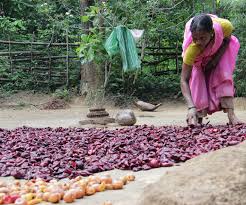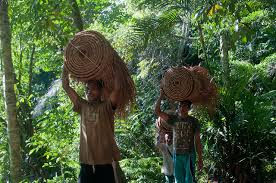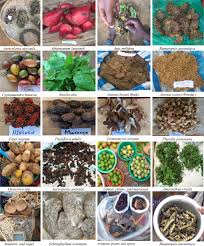The forest is a plant community composed of trees and other vegetation, which contains not only a great quantity of timber reserves but also abundant non-woody plant and animal resources, otherwise known as non-timber forest products (NTFPs) or non-wood forest products (NWFPs).
For example, in China, there are over 1,900 species of woody plants in the forested areas; 340 species of aromatic plants; more than 120 species of edible plants; 400 species of medicinal plants; over 100 species of economic plants; 80 species of nectariferous (nectar-producing) plants; and over 500 species of wildlife.
The Food and Agriculture Organisation (FAO) estimates that 80% of the developing world relies on NWFPs for some purpose in their everyday life. These materials also play an important role in the international marketplace, with over US$1.1 billion in trade.
NWFPs are usually collected locally by peasant farmers, though some have been successfully domesticated for large-scale production, such as honey.
Read Also: The Mango Pistil: Economic Importance, Uses, and By-Products
Non-Timber Forest Products (NTFPs) Overview

These are the huge variety of materials derived from forests, excluding timber and fuelwood. NTFPs include parts of plants, fungi, and other biological materials harvested within, and on the edges, of natural, manipulated, or disturbed forests.
NTFPs include foods (bark, roots, tubers, corms, leaves, flowers, nuts, fruits, fungi, mushrooms, honey, game, gum, sap); food additives (spices, herbs, flavorings, sweeteners); fodder; fibers (for furniture, clothing, and construction); fragrances for perfume; ornamental pods and seeds; resins; oils; and plant and animal products such as meat, skins, teeth, and bones, and those with medicinal value.
Raw materials for NTFPs are gathered from government-owned and communal lands, especially honey, game meat, liana vines, and grasses, where land tenure systems may hinder access to the products. Many of the products are seasonal in supply and depend on natural growth and regeneration, making productivity unpredictable, such as mushrooms.
NTFPs are diverse and vary widely in range across regions, depending on inherent genetic characteristics, land use practices, soil conditions, and environmental influences. Many of these products are available during the farming season, contributing to farming activities.
Read Also: How to Process, Package, and Export Mangoes
Economic and Potential Values of NTFPs

1. Household subsistence: Many NTFPs are used as food, fodder, fibers, grazing supplements, medicine, and construction materials.
2. Food and nutrition: NTFPs provide a wide variety of diets and dietary supplements, which are important sources of nutrients for humans.
3. Income and employment: The exploitation of many NTFPs can provide income to people with limited employment opportunities and low income.
4. Medicinal uses: Several NTFPs are valued for their use in traditional medicine and pharmaceutical preparations.
5. Cultural and spiritual uses: Some NTFPs serve valuable cultural and religious purposes.
6. Cottage industries: Several small-scale industries process NTFPs for domestic and commercial use.
The table below shows the benefits derived from some NTFPs:
| Species | Uses |
|---|---|
| Acacia nilotica | Tannin and dye |
| Pleurotus tuber-regium | Consumed for nutrient supply |
| Gnetum africanum | Consumed for nutrient supply |
| Hynocarpus spp. | Oil used in treating leprosy |
| Irvingia gabonensis | Food and cottage industries |
| Azadirachta indica | Medicinal and jam |
| Parkia spp. | Soup condiment |
| Chrysophyllum albidum | Food, arts, and crafts |
| Garcinia mannii | Chewing stick |
| Indigofera spp. | Dye |
| Acacia senegal | Gum Arabic |
| Vitellaria paradoxa | Shea butter and oil |
| Apis mellifera | Honey |
| Khaya senegalensis | Medicinal |
| Afzelia africana | Cane production |
| Laccosperma secuncli | Mats |
| Pandanus candelabrum | Native salt |
| Rhizophora spp. | Ropes |
Classification of NTFPs
NTFPs can be categorized into four major classes:
1. Culinary NTFPs: Food products from forests such as fruits, leaves, roots, and mushrooms.
2. Wood-based NTFPs: Derived from small, non-timber-sized trees or parts of trees used for fiber and other materials.
3. Floral and Decorative NTFPs: Ornamental flowers, seeds, and decorative plant products.
4. Medicinal and Dietary NTFPs: Forest plants and animals used for medicine, food, and nutritional supplements.
The FAO further classifies NTFPs into three groups:
1. Vegetal NTFPs: Forest plants used for food, forage, fiber, medicine, and biochemicals.
2. Fauna NTFPs: Animals like birds, reptiles, insects, and fish found in forests used for food, fur, pets, hides, and skin.
3. Service NTFPs: Services provided by forests, such as soil improvement, protection, parks, reserves, windbreaks, and historical sites.
This article has shown that several non-timber parts of forest species, including fungi, provide valuable sources of food, food additives, and other essential products for humans.
Do you have any questions, suggestions, or contributions? If so, please feel free to use the comment box below to share your thoughts. We also encourage you to kindly share this information with others who might benefit from it. Since we can’t reach everyone at once, we truly appreciate your help in spreading the word. Thank you so much for your support and for sharing!

